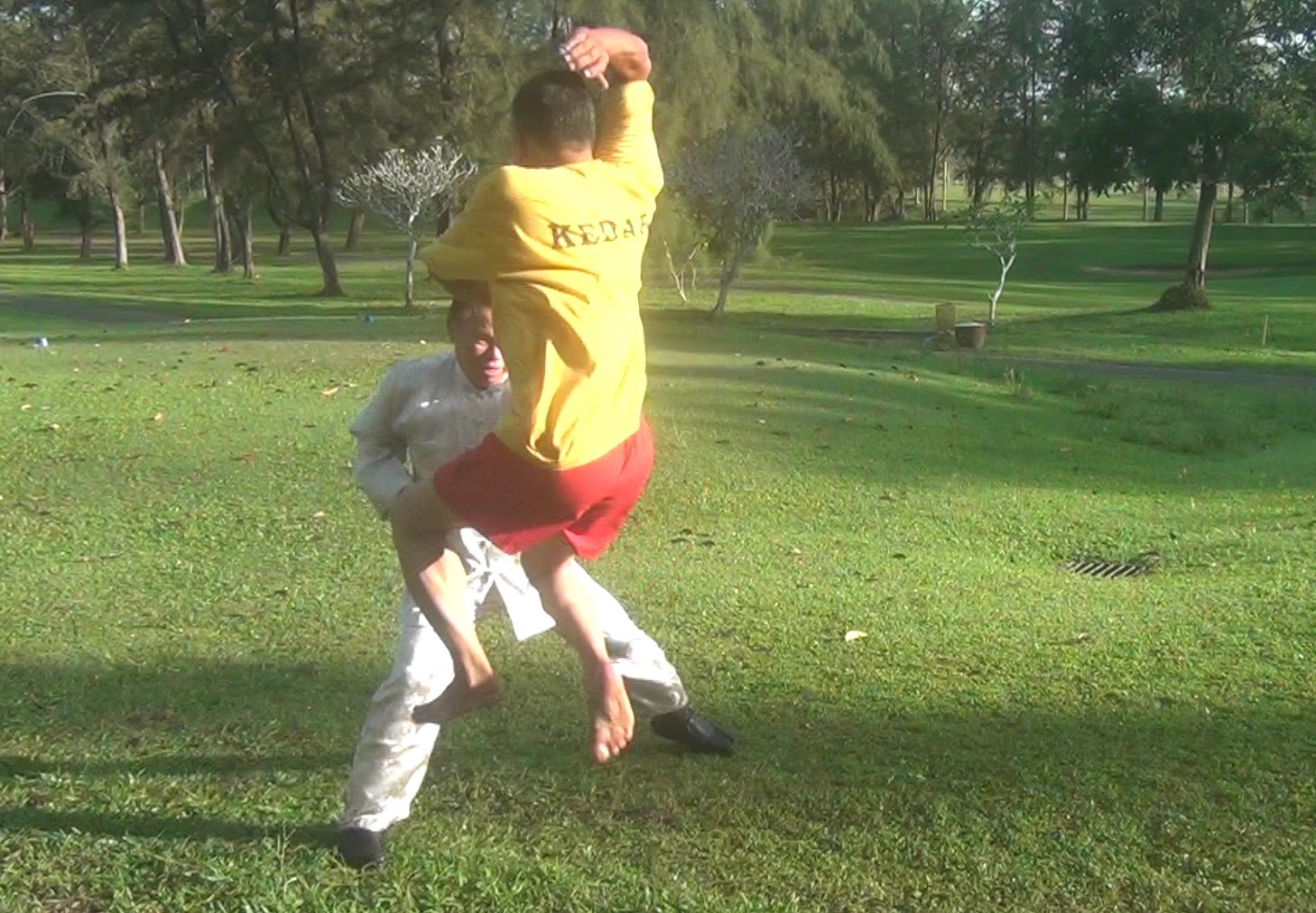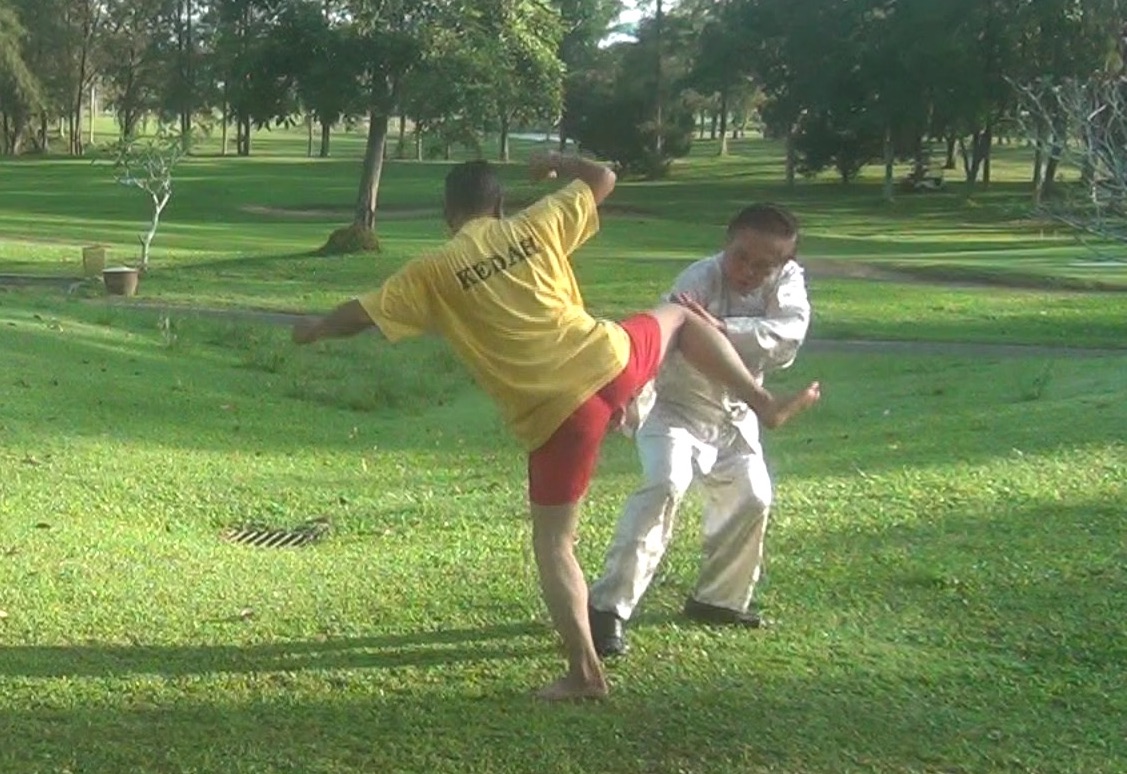GENUINE SHAOLIN KUNGFU

Shaolin Kungfu against Muay Thai
Question
I am a Karate practitioner. In my Karate, the forms are actually very difficult to use. Many of my techniques are derived from forms but have been modified. because many moves in my forms are really very fancy looking and looks very good like dance forms but it's really, really difficult to use in fighting.
-- Kshitij, India
Answer
Your questions are very interesting and will open up many vantage points for martial arts.
All the patterns in Karate can be used for fighting. If you do not know how to use any Karate pattern for fighting, it is just that, i.e. you do not know. It is not that the pattern cannot be used for fighting.
Compared to Shaolin Kungfu or Taijiquan, Karate is straight-forward. One can see the combat applications of Karate patterns easily, but it is difficult to see the combat applications of many Shaolin and Taijiquan patterns.
Many people think that these Shaolin and Taijiquan patterns are flowery. But actually these apparently flowery patterns are very combat effective. Let us look at two examples which I am sending as attachment in this e-mail to you.
The first pattern is called "Heavenly Dragon Descends on Earth", and is taken from Xingyiquan. (Please see the picture above.) The second pattern is called "Cloud Hands", and is taken from Yang Style Taijiquan. (Please see the picture below.)
Many people will find it hard to believe that these two seemingly flowery patterns can be used to counter any attack. I repeat -- any attack!
Can they be used against round-house kicks? Of course. Can they be used against Miay Thai knee jabs to the ribs? Sure. Can they be used to counter a wrestler charging in with a shoot? Certainly. Can they be used against an attacker attempting a throw or a lock? Yes, any throw and any lock! Can they be used against attacks commonly seen in Sanda? This is relatively simple.
These two examples are taken at random. There are many patterns like these in kungfu that look flowery but are very combat effective. You may like my webpages on Is Shaolin Kungfu too Flowery for Combat? and Are these Kungfu Patterns Realistic and Practical in Combat? If you love Taijiquan, you would like A Pattern for All Occasions.
But today most kungfu practitioners do not know how to use them for combat. They do not even know how to use basic kungfu patterns against straight-forward punches and kicks, least of all against sophisticated attacks like throws and locks. Even if they know in theory, they do not have the skills to apply them in practice. Hence, they just bounce about like kick-boxers. The situation of kungfu today is pathetic.
Question
So for better adjusting I had to change the moves from those forms which looked like dancing to be a little different. I changed stances and a lot of things. Now I am able to use some techniques for fighting after having modified, but I'm still studying further. Does that need to be done even in Shaolin or any other Chinese kungfu?
Answer
Many people try to simplify kungfu, but without realizing that they are debasing the art.
Indeed, about 40 or 50 years ago in the 1960s and 1970s, some kungfu masters tried to simplify kungfu into what they called kungfu-do, borrowing the term from Karate, and also emulating Karate techniques and free sparring. Actually they are not kungfu masters, but we call them masters out of respect. Had they mastered kungfu, they would not try to modify and simplify kungfu, debasing it.
The techniques are in an art not because some smart Alex invented them. In the case of kungfu, the techniques were evolved from actual fighting by countless people over many centuries. At first the techniques were straight-forward, like simple punches, kicks and blocks. Over time they became more and more sophisticated, until today they have become so sophisticated that most people do not recognize their combat application.
Question
There are certain videos of yours which I doubt so much. You perform cat stance and keep your hands wide open. The ribs are wide open and it will be easy for a Muay Thai fighter to kick there with force. How do you think that such a fighting stance can help me counter Muay Thai? I mean it does but I feel it doesn’t help every time, and if you can, then please help me more in this aspect.
Answer
I don't know which videos you referred to. But you can be sure of the following three facts:
- Kungfu places a lot of importance on safety first. This means kungfu practitioners (if they practice genuine kungfu) cover themselves well.
- If there is an exposure, it is likely to be a trap (unless the practitioner does not practice genuine kungfu).
- No matter how well you cover yourself, an attacker can still attack you.
There are countless counters I can use if a Muay Thai fighter kicks my ribs with force. I may, for example, use the two examples mentioned above, namely "Heavenly Dragon Descends on Earth" or "Cloud Hands".
It would be interesting to ask how would a fragile-looking lady counter a ferocious Muay Thai fighter. You can get a lot of answers from my webpage Shaolin Counters against Muay Thai Attacks.
Question
Is that technique focusing more on distance maintenance? Or is there any other stance based on traditional Shaolin which you can show where I can cover my ribs and make my legs strong enough to handle Muay Thai low kicks as well as techniques to counter their continuous boxing and punch them back or kick them back?
Answer
As I do not know which technique you referred to, I cannot give you a specific answer. But a general answer is that it does not matter what technique a Shaolin practitioner adopts, he can use it for distance maintenance or close combat. Kungfu is alive.
This applies to all styles of kungfu, not just Shaolin. Of course, the practitioner must be practicing genuine kungfu. Unfortunately today most practitioners only practice external kungfu forms, and bounce about when they have to spar.
Making your legs strong enough to handle Muay Thai low kicks or any attacks is third-class kungfu. In first-class kungfu you don't have to meet your opponent's strong legs.
Using techniques to counter a Boxer's continuous punches or a Kick-Boxer's continuous kicks is third-class kungfu. In first-class kungfu the Boxer or Kick-Boxer has no chance to throw his second punch or kick, or not even the first punch or kick.
You can see some first-class kungfu used by a fragile-looking lady against a ferocious Muay Thai fighter in the webpage mentioned above.

Shaolin Kungfu against Muay Thai
LINKS
